| 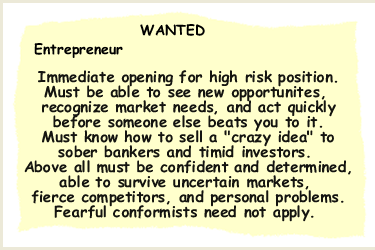
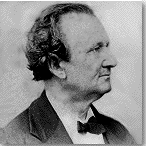 Americans
always love a success story, particularly when the hero comes
from the ranks of the common man. The entrepreneurs who opened
up the logging industry in northern California were not well
educated, socially polished, winners of talent contests, or
paragons of virtue. They were, for the most part, common men,
who believed in success, brushed off failure, and convinced
others to buy into their vision. When they failed, they failed
forward. Henry "Honest Harry" Meiggs is a case in
point. Americans
always love a success story, particularly when the hero comes
from the ranks of the common man. The entrepreneurs who opened
up the logging industry in northern California were not well
educated, socially polished, winners of talent contests, or
paragons of virtue. They were, for the most part, common men,
who believed in success, brushed off failure, and convinced
others to buy into their vision. When they failed, they failed
forward. Henry "Honest Harry" Meiggs is a case in
point.
Born in Catskill,
New York on July 7, 1811, Henry Meiggs first worked in his
father's shipyard, building piers and small boats. Business
was good. Before railroads and highways, rivers were America’s
main arteries of transportation and commerce..By necessity,
America's early colonists lived mainly by water, not deep
in the woods or high on the mountaintops. The most important
river in America’s early history was the Hudson River,
defended by America’s early Revolutionaries, used for
commerce, and celebrated by writers and pastoral painters
for its beauty. The Hudson River ran for 315 miles from its
headwaters in the Adirondacks, through small town America—Saratoga,
Catskill, Poughkeepsie, Cornwall, West Point, Yonkers—finally
spilling out into the Atlantic Ocean at New York City.
Perhaps as inevitably as the Hudson River itself, Meiggs made
his way to the big city, fired with dreams and ambition. Before
he turned 21, he married Gertrude Burns on April 9, 1832.
One year later, on April 12, they had a son, William. Within
seven months of William's birth, Meiggs buried his wife. A
widower and single father, Meiggs worked as a Manhattan lumber
dealer and contractor, managing to amass a moderate fortune
within a couple years. The 1830s, however, were a decade of
wild financial speculation and spending. Fortunes were made
and quickly lost. Meiggs' lumber business was among many that
failed. In an age when there were no social programs for unemployment,
Meiggs, like others of his generation, turned to family for
survival—if they were lucky to have one. Meiggs moved
near his married sister in Williamsburg, a town that later
became part of Brooklyn, and joined his brother-in-law's lumber
business. Henry Meiggs pressed on.
On September
7, 1835, Meiggs married a second time to Caroline Doyle. She
became at once a new wife and a mother to William, who was
not yet 2 ½. Struggling to raise a family, Meiggs would
learn that the financial roller-coaster ride was not over.
The Panic of 1837 hit New York City on May 10; all banks stopped
payment in gold and silver coins. This was the start of a
six-year economic depression in which banks failed, unemployment
soared, public construction projects halted, and people rioted
in the streets of New York City for food. Life goes on, however,
even in times of economic or social turmoil. In 1839, Meiggs
and Caroline had their first child together, a son, Carroll.
He lived about 3 weeks past his second birthday. In 1842,
Caroline bore another child, a girl also named Caroline. Little
Caroline died 3 months before her own second birthday. Childbirth
and childhood were dangerous times in 19th century America.
By 1848, having
heard about the Gold Rush, Meiggs set his sites for California.
However, the 38-year old, Meiggs did not intend to sift California
rivers or dig California valleys for gold. Loading a ship,
the Albany, with lumber, he set sail for San Francisco with
his family in early 1849. His family now included teenager,
William; 3 1/2-year old, Henry; and an infant son, Manfred,
born September 7, 1848. Considering that the trip to San Francisco
went from New York, around Cape Horn, and up the California
coast—a trip of almost three months at sea—one
can only admire the optimism and stamina of these parents.
Stepping off the ship at San Francisco, Meiggs and his wife
would have seen muddy streets filled with mules, horses, dogs,
canvas tents, blanket tents, makeshift houses and stores,
brothels, gambling spots, saloons, and more saloons. There
would also have been plenty of noise, muck, and aroma—not
a golden city, by any means, except in the opportunities it
offered to make quick money. Reportedly Meiggs sold the lumber
he brought from New York for twenty times what he paid for
it and began his short career as a California businessman.
In a little more than a year after coming to San Francisco,
however, tragedy struck the Meiggs family again. William died
on September 9, 1850, scarcely more than 17 years old. Henry
Meiggs pressed on.
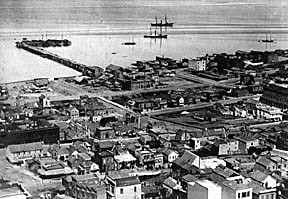 San
Francisco was growing fast and burning faster. Between 1849
and 1851 there were six fires in San Francisco costing millions
of dollars in damage. Lumber was needed to build and re-build
San Francisco. Meiggs started a lumber business in North Beach,
convinced that this area would soon be booming with new homes
and stores. Always a salesman and promoter, he invested heavily
in North Beach real estate and encouraged new friends and
business colleagues to do the same. He bought a sawmill at
Bodega Bay and built another at the headlands of Mendocino.
In a labor-intensive age, he employed approximately 500 men.
Around this time, Meiggs and Caroline had another son, Minor
Keith, born October 16, 1852. By 1853 Meiggs had also completed
Meiggs Wharf, which extended 1600-2000 ft from the base of
Powell Street into San Francisco Bay. The photo to the left
shows Meiggs Wharf in the 1860s. San
Francisco was growing fast and burning faster. Between 1849
and 1851 there were six fires in San Francisco costing millions
of dollars in damage. Lumber was needed to build and re-build
San Francisco. Meiggs started a lumber business in North Beach,
convinced that this area would soon be booming with new homes
and stores. Always a salesman and promoter, he invested heavily
in North Beach real estate and encouraged new friends and
business colleagues to do the same. He bought a sawmill at
Bodega Bay and built another at the headlands of Mendocino.
In a labor-intensive age, he employed approximately 500 men.
Around this time, Meiggs and Caroline had another son, Minor
Keith, born October 16, 1852. By 1853 Meiggs had also completed
Meiggs Wharf, which extended 1600-2000 ft from the base of
Powell Street into San Francisco Bay. The photo to the left
shows Meiggs Wharf in the 1860s.
While Meiggs was making considerable
money in his lumber business, he was also spending considerable
money on North Beach real estate deals that did not prove
as profitable as he had expected. Interest on loans and taxes
on property began to mount. With the depression of 1854, Meiggs
was faced with huge debts—some estimates put the amount
as much as $1,000,000 with the interest alone between $30-40,000
a day (Harker, 196). A San Francisco alderman, Meiggs apparently
had access to a book of blank city warrants, already signed
by the major and the city comptroller. "Hnoest Harry"
forged the warrants and presented them as collateral for his
loans.
At this point, a melodrama, worthy of any 19th century theater,
unfolded. Reportedly, Meiggs skipped town with a "fire
burning in the hearth and the birds singing in their cages."
Sometime in early October, 1854, Meiggs quietly loaded everything
from his San Francisco mansion at Broadway and Montgomery,
including vintage wines and $10,000 in gold, onto the ship,
American, which, not coincidentally, one would guess, had
four small cannons mounted on its deck (Averbuch, 20). In
darkness and lifting fog, Meiggs sailed for South America
with his family and his brother, John, the newly elected city
comptroller of San Francisco. With daylight, angry creditors
mounted a search for Meiggs. His creditors included William
Tecumseh Sherman, who would prove to be a better Civil War
general than a banker. Sherman was a partner in a St. Louis
banking firm operating in San Francisco at the northeast corner
of Montgomery and Jackson. Of those wild days of financial
speculation that brought the ruin of Meiggs and others, Sherman
later reminisced: "I can handle a hundred thousand men
in battle, and take the City of the Sun, but am afraid to
manage a lot in the swamp of San Francisco" (Royster,
133-4). A court subsequently indicted Meiggs for fraud but,
in South America, he was quite beyond the reach of California
law. Henry Meiggs pressed on.
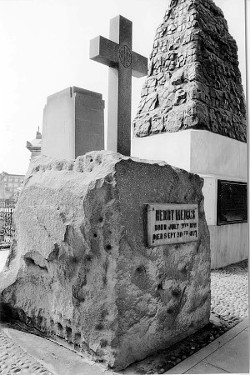 In Chile, Meiggs and Caroline had their last child, Fanny
Kip, born October 26, 1856. Despite his detractors, Meiggs
wrote to Laura Nelson from Santiago, Chile on September 11,
1859, that "my hopes are still strong, and my spirit
uncrushable, notwithstanding what has been
said and written of me." On Christmas Day, 1861, Meiggs
suffered yet another loss, when his wife died in Santiago.
Throwing himself into work, Meiggs constructed, by 1867, about
200 miles of railroad in Chile, much of it along the coast.
In 1868 he went to Peru, where there were less than 60 miles
of railroad track. With only an elementary school education,
quite typical for the times, Meiggs, with the assistance of
engineers J.L. Thorndyke and E. Malinowski, built the beginnings
of the most important Andean railroad lines still in existence
today. One of them, the Callao-Lima-Oroya railroad, was the
highest standard gauge railway in the world, crossing the
Andes at about 17,000 ft above sea level. Meiggs would boast
“I will lay tracks where llamas walk.” Meiggs
imported rail cars from the eastern United States and rails
from England. And the railroad ties? California redwood! As
a contractor, Meiggs used redwood ties for other Peruvian
rail projects as well. Writing about the Oroya Railroad for
Scribner's magazine in August, 1877—just a month before
Meiggs death on September 30th—J. Eglinton Montgomery
lionizes the American entrepreneur, saying that "the
Oroya Railroad must take rank in the history of modern engineering
as a work of the first magnitude, without a rival" (Montgomery,
462).
In Chile, Meiggs and Caroline had their last child, Fanny
Kip, born October 26, 1856. Despite his detractors, Meiggs
wrote to Laura Nelson from Santiago, Chile on September 11,
1859, that "my hopes are still strong, and my spirit
uncrushable, notwithstanding what has been
said and written of me." On Christmas Day, 1861, Meiggs
suffered yet another loss, when his wife died in Santiago.
Throwing himself into work, Meiggs constructed, by 1867, about
200 miles of railroad in Chile, much of it along the coast.
In 1868 he went to Peru, where there were less than 60 miles
of railroad track. With only an elementary school education,
quite typical for the times, Meiggs, with the assistance of
engineers J.L. Thorndyke and E. Malinowski, built the beginnings
of the most important Andean railroad lines still in existence
today. One of them, the Callao-Lima-Oroya railroad, was the
highest standard gauge railway in the world, crossing the
Andes at about 17,000 ft above sea level. Meiggs would boast
“I will lay tracks where llamas walk.” Meiggs
imported rail cars from the eastern United States and rails
from England. And the railroad ties? California redwood! As
a contractor, Meiggs used redwood ties for other Peruvian
rail projects as well. Writing about the Oroya Railroad for
Scribner's magazine in August, 1877—just a month before
Meiggs death on September 30th—J. Eglinton Montgomery
lionizes the American entrepreneur, saying that "the
Oroya Railroad must take rank in the history of modern engineering
as a work of the first magnitude, without a rival" (Montgomery,
462).
In constructing the Oroya railroad, Meiggs had to blast the
Galera, a tunnel about 3,847 feet in length at an altitude
of 15,645 feet. In sight of Galera tunnel is Mount Meiggs,
where the Peruvian and U.S. flags once flew together on its
snowy summit (Montgomery, 459). Fittingly, a boulder from
Galera tunnel marks the grave of Henry Meiggs in Lima, Peru.
At the time of his death, Meiggs was only survived by three
of his seven children: Henry, Minor Keith, and Fanny Kip.
Significantly, Meiggs, before his death, made restitution
to many of his San Francisco creditors, evidenced by the fact
that in 1874, the California legislature passed Senate Bill
183 dismissing any previous indictment against him
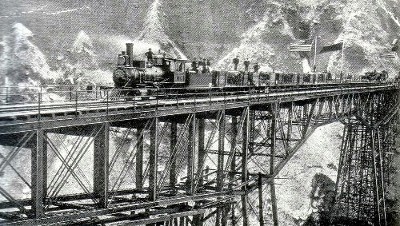
Author:
DMS |
| Photo
Credits
Henry Meiggs,
Kelly House Research
Office (Mendocino, CA).
Henry Meiggs Tomb, courtesy
of Elio Galessio (Peru).
Verrugas Bridge, built by
Meiggs and at the time the highest bridge in the world. Photo
shows Engine #13, Santo Domingo, c. 1890, with U.S. and Peruvian
flags flying, courtesy of Elio Galessio (Peru).
Secondary Sources
Averbuch, Bernard. Crab is
King, Mabuhay Publishing Company, 1973.
Harker, Mary Margaret. "Honest
Harry" Meiggs, California Historical Society Quarterly,
Vll. XVII, No. 3 (September 1938).
Meiggs, Henry. Copy of a Letter
to Laura A. Nelson, 11 September 1859, Kelly House Museum
Research Office.
Montgomery, J. Eglinton. "A
Railroad in the Clouds." Scribner's, Vol. XIV, No. 29
(August 1877).
Myers, Elisabaeth P. South
America's Yankee Genius. New York: Julian Messner, 1969.
Royster, Charles. The Destructive
War: William Tecumseh Sherman, Stonewall Jackson, and the
Americans, Alfred A. Knopf, 1991.
|